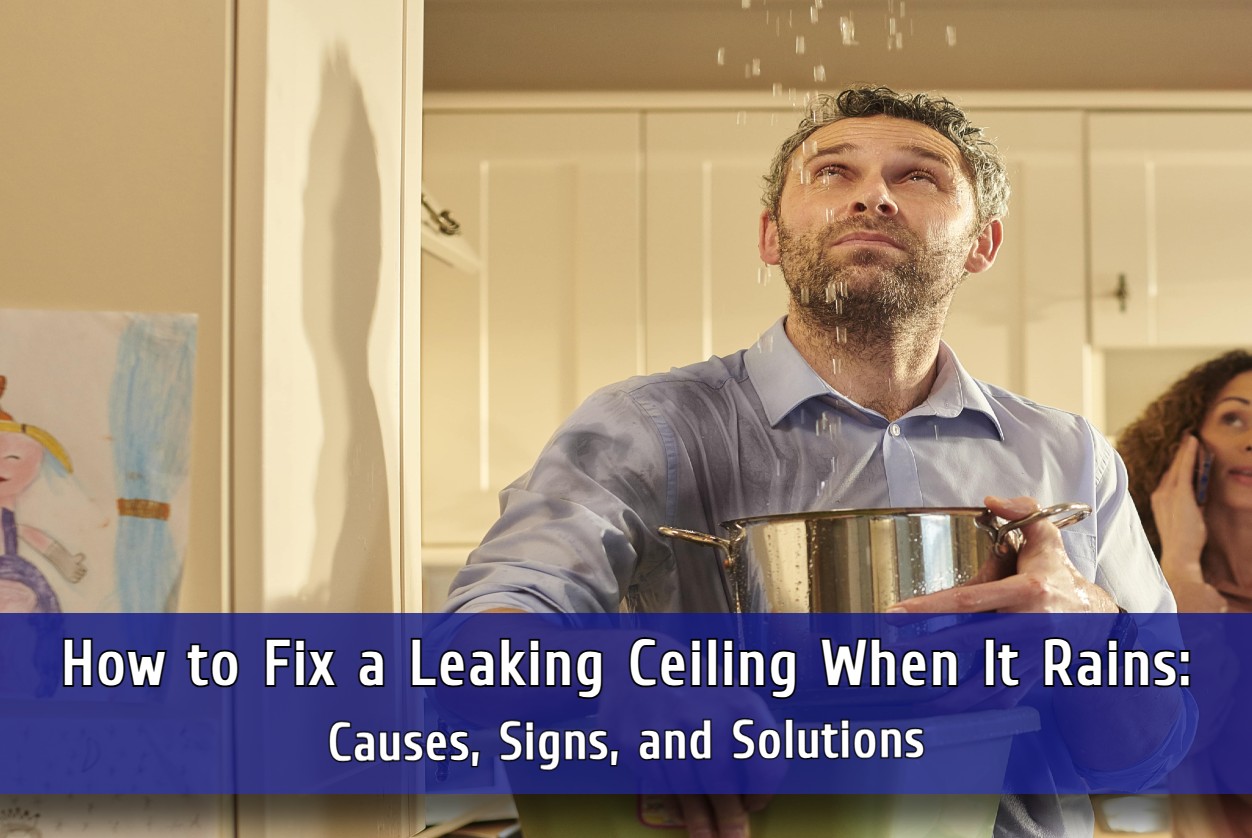When you’re sitting safe and dry in your home during a rainstorm, the last thing any homeowner wants to see is water dripping from the ceiling. If a ceiling leaks when it rains it can be a sign of significant issues that need immediate attention.
For homeowners, knowing the signs that indicate a roof is leaking and using temporary solutions can be invaluable when it comes to preventing further damage until professional help arrives. That’s why, in this blog post, we aim to help you understand the signs that indicate your roof is leaking, including actions to take when you come across a roof leak. Keep reading to learn about the practical steps and preventive measures to safeguard your home against the challenges posed by harsh weather.
Identifying the Source of the Leak
Knowing the signs that indicate a roof leak is crucial in case you ever find yourself in a situation where your roof is leaking during a rainstorm. Homeowners should look for water stains or discoloration on the ceiling, dripping water during or after rainfall, and any unusual mustiness in attic spaces. These signs often point to potential areas of damage that allow water to enter and accumulate, leading to visible ceiling leaks.
Knowing the difference between roof leaks and other types of water damage is also important. While roof leaks typically appear during, or shortly after rain, other forms of water might stem from plumbing defects or condensation problems, which persist regardless of the weather. By correctly identifying the source as a roof leak, homeowners can focus on the appropriate repairs, such as employing the best sealant for patching or considering more extensive solutions if necessary.
The Causes of Roof Leaks in Heavy Rain
Vulnerabilities in the roofing system tend to cause roof leaks during heavy rain. These vulnerabilities may include aged or damaged shingles, inadequate or improperly installed flashing, and sealant that has worn down.
External factors also play a significant role in roof leaks becoming worse. For instance, heavy winds can lift shingles, allowing rainwater to seep underneath and get through to the underlayment. Similarly, debris such as fallen branches or leaves can block water flow on the roof, causing water to pool and eventually penetrate through weak spots in the roof’s structure. Understanding these causes is essential in order to accurately address a leaking ceiling when it rains, as it helps you target the specific issue quickly.
Practicing regular roof maintenance can help you identify and solve these issues before they lead to significant damage too. Since inspections are part of a regular maintenance routine, assessing the roof for damage before a storm even hits can help you stop leaks before they start.
Temporary Solutions for a Leaking Roof
While waiting for professional roofing contractors to arrive and address a leaking ceiling, homeowners can implement several temporary solutions to manage water intake. It is crucial to act swiftly to minimize the impact of the leak. One effective quick fix is to apply a waterproof tarp over the affected area on the roof. This method can help divert water away from the compromised sections and prevent it from getting into the home in the first place.
If you’re unable to tarp a roof prior to a storm, another temporary solution involves using buckets or other containers to catch dripping water inside the house. This can help prevent the spread of moisture and protect your floors and furniture from water damage. Homeowners can also consider applying patches or roof sealants specifically designed for wet conditions to areas where leaks are apparent. Sealants can provide a temporary barrier against water leaks until a more permanent fix can be implemented.
When applying these temporary fixes, safety should always come first. Homeowners should avoid climbing onto a wet or damaged roof, as this can be extremely hazardous. Instead, if the situation allows for it, apply the sealant or patch from inside the attic, or by using a ladder with proper support. It’s also advisable to wear protective clothing and slip-resistant shoes to reduce the risk of hurting yourself.
While these temporary solutions can help reduce the immediate effects of a roof leak, they are not long-term fixes. Professional assessment and repair are essential to address the underlying issues causing the leak, ensuring the integrity and safety of your home in the future.
Permanent Repair Solutions
To permanently resolve issues that cause a roof to leak when it rains, it is crucial to follow a comprehensive step-by-step guide tailored to address the root cause. This involves more than just temporary fixes, it requires a thorough approach to ensure the leak does not occur again.
The process should start with the roof being inspected thoroughly for any visible signs of damage such as broken or missing shingles, cracked flashing, or worn sealant. These are often the primary entry points for water, so once the damaged area is identified, clean it thoroughly to remove any debris or residue that might prevent the new sealant from adhering properly.
After identifying the source of the leak, the next step is to remove any damaged roofing material. For shingle roofs, this involves carefully lifting the shingles surrounding the leak and removing the nails. If the leak is around flashing, such as around a chimney or vent pipe, remove the old flashing and any surrounding shingles. Ensure all damaged materials, including the underlayment, are removed to expose the roof deck.
Depending on the severity of the leak, you may have to repair the roof deck or replace the underlayment in order to ensure that the leak does not occur again. Afterward, you’ll install the new shingles or flashing, depending on the compromised material.
For shingles, start by placing new ones at the bottom of the repair area and work your way up, ensuring each row overlaps the one below it. Secure each shingle with roofing nails, ensuring the nail heads are covered by the shingle above to prevent water from getting through. For flashing repairs, cut the new flashing to fit the area and secure it with roofing nails or screws, then apply roofing sealant around the edges to create a watertight seal.
To confirm whether your repair was effective or not, use a garden hose and allow water to gently flow over the repaired area to ensure that no leaks occur. Always keep in mind that while it may seem easy to make these repairs yourself, for the best results you’ll want to hire a professional roofing contractor who can ensure that leaks will no longer occur in these areas.
Cost Considerations for Repairing Ceiling Water Damage
Understanding the factors that influence how much it will cost to repair ceiling water damage is crucial for homeowners facing leaks during heavy rain. The extent of damage, the quality of materials used for repairs, and the complexity of the work required are all significant. You should also check local labor rates to determine how this will affect your overall cost.
When estimating the cost of repairs, it’s important to consider the size of the affected area and the difference between structural repairs versus cosmetic fixes. More extensive damage will generally require a higher investment, but addressing issues quickly can prevent more severe problems and higher costs down the line.
To budget effectively, start by getting multiple estimates from reputable contractors. This will give you a realistic idea of the costs involved and help you plan financially.
Preventative Measures for Future Protection
To prevent future leaks and safeguard your home against the challenges posed by heavy rain, regular maintenance and the use of professional roofing services are essential. In Central Ohio, where weather conditions can be harsh, taking proactive steps to maintain your roof’s integrity is crucial.
Regular maintenance should include cleaning gutters and downspouts to ensure they are free from debris, which can cause water to back up and seep under the roofing materials. Inspecting the roof for signs of damage such as cracked or missing shingles, and ensuring all sealant and flashing are intact, can prevent water from entering your home.
Professional roofing services in Central Ohio offer solutions that go beyond simple repairs. These services include comprehensive assessments of your roofing system to identify potential vulnerabilities before they lead to serious issues. Professionals can also suggest improvements or upgrades to your roofing materials and design, which can significantly enhance your roof’s resilience against future leaks.
By adhering to these preventative measures and utilizing professional services, homeowners can effectively manage the risks associated with roof leaks during heavy rain. This proactive approach not only protects the structural integrity of your home but also helps in managing potential costs related to repairing ceiling water damage effectively.
Find Quality Roof Repair & Tarping Services in Central Ohio With AM Roofing & Siding
If you’re dealing with a leaking ceiling during heavy rain, don’t wait for the problem to worsen. The experts at AM Roofing & Siding are ready to offer all of Ohio their professional roofing services. Our experienced team specializes in identifying and fixing roof leaks, offering permanent solutions to safeguard your home from water damage.
Even if you just want temporary protection, we’re the team for you. Our efficient roof tarping service gives you the much-needed protection you need in the face of a storm. Don’t let a leaking ceiling disrupt your peace of mind, take proactive steps to address the issue with our professional assistance. Contact us today at (740) 974-8268 to learn more about how we can help you!

